Gregory A. Fournier's Blog, page 11
September 22, 2020
Alex Karras' NFL Gambling Suspension--Part One of Three
Detroit Lion tackle Alex Karras
The trouble started in 1961 when reports of Detroit Lion Alex Karras' gambling on professional sports and associating with underworld figures reached the desks of Lions owner William (Bill) Clay Ford and NFL commissioner Pete Rozelle. Detroit police commissioner George Edwards and the local FBI had Karras under surveillance for a year because of his association with Jimmy and Johnny Butsicaris and his co-ownership of the popular Lindell AC (Atheletic Club) sports bar.
Alex Karras met the Butsicaris brothers soon after he arrived in Detroit to play for the Lions. The bar was known for its legendary hamburgers and walls festooned with sports memorabilia. It became a hangout for sports writers, sports fans of every stripe, and shady characters who enjoyed rubbing elbows with local team players like everyone else did.
Some of these characters happened to be professional gamblers. Karras liked the place because the owners were Greek and their place reminded him of his hometown Gary, Indiana. The Lindell AC was his refuge where he could relax and relate to people.
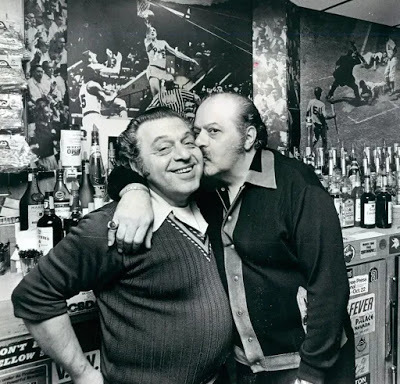 Johnny and Jimmy Butsicaris
Johnny and Jimmy Butsicaris Karras became a regular customer and was befriended by the brothers. When their bar opened in 1949, Meleti Butsicaris and his sons each owned one-third of the business. After their father died, the brothers asked Karras if he would like to buy their father's share, so they could move the bar to a better location down Michigan Avenue and renovate an available property. For a $45,000 buy-in, Karras became a partner.
To compound gambling suspicions against Karras, his favorite restaurant in Detroit was The Grecian Gardens in Greektown. Gus Colacasides was the owner and basically the patriarch of all local Greeks in Detroit. Karras liked the authentic Greek food and the atmosphere and went there weekly. I can personally vouch for the quality of their food.

The restaurant's late night clientele included gamblers, bookies, and ranking underworld figures. Some pretty tough customers would see Karras and come up and shake his hand and strike up a sports conversation. At the heart of it, they were sports fans and Karras was a Lion celebrity. Soon, he felt like one of the boys.
All the while, Karras was under police surveillance everywhere he went. In 1962, the general manager of the Lions Andy Anderson summoned Karras into his office and cautioned him about being in the bar business with the Butsicaris brothers. "They're gangsters and hoodlums--stay away from them."
"The Hell I will!"
"If you stay in the bar business with them, the Lions will take steps."
"Tell Bill Ford that I need the work because I can't raise my family on the lousy $12,000 a season he pays me."
For the first few years of his NFL career, Karras wrestled "professionally" in the off-season as part of a masked tag team attraction to make financial ends meet. Now that he had a growing family, he was tired of travelling every weekend throughout the Midwest.
Karras had known Jimmy and Johnny Butsicaris for two years and knew they were not connected to organized crime. They were hard-working saloon owners, and these alleged "gangsters" were their customers. It was free enterprise and that wasn't a crime.
But then there was the issue of Karras and a fellow teammate John Gordy riding home after an exhibition game against the Cleveland Browns on a "party bus" owned by Vito Giacalone, but it was registered to Odus Tincher--a retired DSR bus driver, known gambler, and former convict. The Giacalone brothers were also known gamblers and underworld crime figures connected with the Detroit Partnership (Mafia). The Detroit Police and the FBI wondered why the party bus was often parked in back of the Lindell AC when not in service.
End of Part One
September 17, 2020
The Seven Deadly Sins: Then and Now
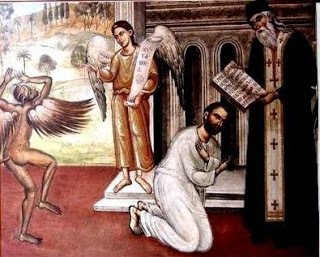 Parishoner receiving the sacrament of Confession.
Parishoner receiving the sacrament of Confession.Western Catholicism has always had trouble explaining the problem of evil in a world created by a benevolent god. Medieval theologians personified sin in the guise of Satan, an angel who rebelled against God and was cast from Heaven. It was Satan who unleashed sin upon the earth and poisoned men's minds. The struggle between obedience to God and a human beings' free will became the battleground for man's immortal soul. The stakes couldn't be higher--salvation or perdition.
Though not explicitly mentioned in the Bible, the Seven Deadly Sins became fundamental to Roman Catholic doctrinal and confessional practices in Medieval Europe. The Catholic church promoted the concept of the Seven Deadly Sins in church sermons and religious artwork encouraging the faithful to curb their sinful ways. The origin of the Seven Deadly Sins is linked to the works of fourth-century Greek monk Evagrius Ponticus. One of his disciples--John Cassian--brought these categories to Europe and translated them into Latin--the common language of the Roman Catholic Church. The sins were Pride, Greed, Gluttony, Wrath, Envy, Sloth, and Lust.
Medieval priests studied the Seven Deadly Sins in penitential manuals training them to hear confessions. After a parishioner's admission of sin, priests assigned prayers for penance usually involving the recitation of Hail Marys and Our Fathers and an Act of Contrition before the priest would absolve your sins. Sometimes wealthy patrons made contributions to the church hoping to buy their way into heaven.
The Seven Deadly Sins were given popular expression during the Renaissance in Dante's Inferno (1320 AD), an anonymous writer's The Summoning of Everyman (1510), and Christopher Marlowe's Doctor Faustus (1604). Each fictional treatment was a cautionary, morality tale.

Dante envisioned the nine circles of Hell in his Inferno. The lustful are condemned to the 2nd circle; the gluttonous are grouped in the 3rd circle; the greedy inhabit the 4th circle; and the wrathful are imprisoned in the 5th circle. Four of the nine circles are dedicated to the Seven Deadly Sins. Though Hell is never mentioned explicitly in the Bible, Dante and the clergy did not mind scaring it out of people.
After a lifetime of sinning, the main character in The Summoning of Everyman must make an accounting of his life which is sorely wanting. Everyman's eternal soul is not in a state of grace. Death summons Everyman, but Everyman is unprepared to face his judgement and tries to delay his fate. To make amends, he confesses his sins to a priest, does his penance, and is administered the Last Rites. All his worldly goods, his friends, and family give him no comfort in his time of greatest need. Only his Good Deeds follow Everyman to the grave. The moral, of course, is prepare in this life for the next.
 The Tragical History of Doctor Faustus is the most subversive play of the period. Faustus is a heretical priest who dares to study the forbidden secrets of necromacy (conjuring demons). His excessive pride prompts him to brag that he has studied every subject and finds them all wanting. He denounces Logic as merely a tool for arguing; he proclaims that Medicine is useless unless it can conjure up the dead; he feels that the Law is mercenary and beneath him; and that Divinity is useless, which is blasphemy against God.
The Tragical History of Doctor Faustus is the most subversive play of the period. Faustus is a heretical priest who dares to study the forbidden secrets of necromacy (conjuring demons). His excessive pride prompts him to brag that he has studied every subject and finds them all wanting. He denounces Logic as merely a tool for arguing; he proclaims that Medicine is useless unless it can conjure up the dead; he feels that the Law is mercenary and beneath him; and that Divinity is useless, which is blasphemy against God.Corrupted by practicing the black arts, Faustus creates a magic circle and attempts to summon Satan. Instead, the devil Mephistophilis (sic) appears and strikes a deal with Faustus giving him magical powers for twenty-four years until he must surrender his soul. Faustus is introduced to the Seven Deadly Sins and lives a self-indulgent life until it is time to pay for his devil's bargain. His corrupted soul is drawn to the everlasting bonfire of Hell.
***
In our more secular age, the Seven Deadly Sins have lost their power to shock or discourage many wayward sinners, but they haven't lost their power to captivate the popular imagination and produce box office gold for filmmakers. Though many twentieth-century films clearly deal with the concept of sin and morality, the theme is often implied rather than expressed.
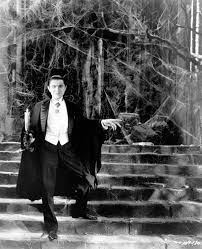 Dracula
DraculaOne of the earliest Hollywood morality tales was the 1931 horror film Dracula, about a vampire who attacks godfearing humans and robs them of their souls. Lust and sacrilege are the movie's subtext as Dracula is hunted down and destroyed with a wooden stake driven through to his heart while in his coffin. This film made an international sex symbol of Hungarian Bela Lagosi, and it started the era of the Universal Pictures costume monsters. Released nine months later, Frankenstein was another 1931 monster movie that left its mark on the moviegoing public. The film is about an ambitious scientist who dares to emulate God by creating a human life. Pride in his achievement is a direct affront to God. Dr. Frankenstein's transgression creates a monster that unleashes murder and mayhem upon the countyside.
This film helped promote the Hollywood cliche of the mad scientist. For his pursuit of the mysteries of life and death, Dr. Frankenstein goes insane. Costume monsters like Dracula and Frankenstein lost their power to scare audiences in the 1950s after Hollywood entered the post World War II era of the psychological thriller. The movie that changed the horror genre forever was 1960's Psycho directed by Alfred Hitchcock. The film was groundbreaking for its unprecendented depiction of sex and violence which set a new standard of acceptability for feature films. The movie ended with a psychologist's evaluation of the killer's motivation and mental state. No attempt was made to provide any religious context for the audience, although the deadly sins of greed, lust, and wrath run throughout the film. [image error] Janet Leigh in Psycho
Psycho viewers enjoyed the rush of jumping out of their seats screaming--especially during the famous shower scene. To offer guidance to their parishioners, the Catholic Legion of Decency gave the film a B rating for being "morally objectionable," but the public loved the film and long lines formed wherever it was shown. For a modest capital investment of $806,947, Psycho made $50 million dollars becoming one of the most profitable movies of its era.
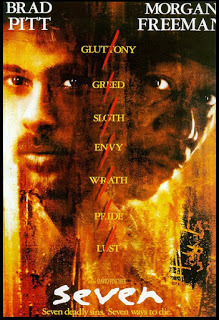 The most explicit treatment of the Seven Deadly Sins in a modern movie is the film Seven--a psychological thriller starring Morgan Freeman, Brad Pitt, Gwyneth Paltrow, and Kevin Spacey. Serial killer John Doe drops clues at five murder sites, each resembling a different deadly sin. Two detectives frantically pursue the unknown serial killer before he acts on the final two deadly sins.
The most explicit treatment of the Seven Deadly Sins in a modern movie is the film Seven--a psychological thriller starring Morgan Freeman, Brad Pitt, Gwyneth Paltrow, and Kevin Spacey. Serial killer John Doe drops clues at five murder sites, each resembling a different deadly sin. Two detectives frantically pursue the unknown serial killer before he acts on the final two deadly sins.By committing horrific murders linked to the deadly sins, a religious zealot wants to incite the public to repent for their sins. John Doe wants to be known as a martyr in service to God's will, despite committing the mortal sin of murder repeatedly. This film had a $33 million dollar budget and earned $327.3 million dollars worldwide making it the fifth most popular American film of 1995. What the movie did for church attendance is unknown.
Today, the problem of evil with its enduring themes of sin and transgression are the stock in trade of writers and movie producers. Rather than morality lessons that lead people to God, these modern films are popular for their ability to thrill and entertain mass audiences. Danse Macabre (Dance of the Dead)
September 10, 2020
MAD Magazine Pulls the Plug on Alfred E. Neuman
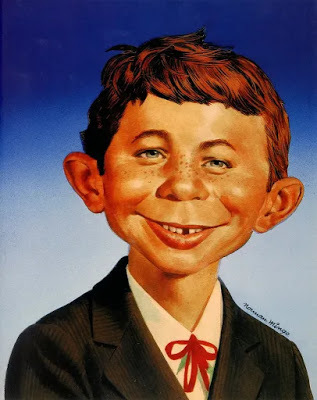 Alfred E. Neuman
Alfred E. NeumanOn the occasion of MAD magazine's final issue, the New York Times wrote that Mad was the "Irreverant Baby Boomer's Humor Bible." The publication had a glorious sixty-six-year run with 550 issues serving up a mixture of adolescent humor and social satire of pop culture, advertising, politics, and entertainment. MAD has been called the "class clown of American publishing."
Generations of kids loved MAD, much to the dismay of their parents. Television shows like The Simpsons, Monte Python and Saturday Night Live owe much to MAD and its legion of talented writers and artists, known collectively as "Our Usual Gang of Idiots." People like Mort Drucker, Don Martin, Frank Jacobs, Norman Mingo, Al Jaffee, and hundreds of other talented people over the magazine's long history.
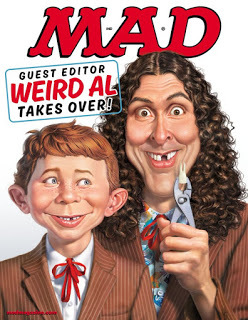 People like Robert Crumb, creator of Zap Comix, standup comedian Jerry Seinfeld, film critic Roger Ebert, and musical satirist Weird Al Yankovic all were influenced by MAD. Upon learning of the magazine's demise, Weird Al tweeted, "I can't begin to describe the impact MAD magazine had on me as a young kid."
People like Robert Crumb, creator of Zap Comix, standup comedian Jerry Seinfeld, film critic Roger Ebert, and musical satirist Weird Al Yankovic all were influenced by MAD. Upon learning of the magazine's demise, Weird Al tweeted, "I can't begin to describe the impact MAD magazine had on me as a young kid."MAD originally launched as a comic book in 1952 and became a magazine in 1955. The format was changed in response to the United States Senate hearing to investigate the menace of comic books. The hysteria was based on the research of psychologist Fredric Wertham's best-selling book with the lurid title The Seduction of the Innocent, which purported that comic books contributed to "children's maladjustment." Comic books were banned and burned in some communities.
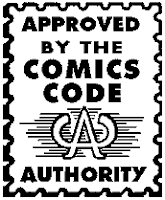 Look familiar?The Comics Magazine Association of America was formed in 1954 by the comic book industry to avoid threatened government regulation, despite being a censorship First Amendment issue. The CEOs ran scared and formed the self-governing Comic Code Authority (CCA) and set up a series of standards before they would grant their Seal of Approval on a comic's front cover if it met the Authority's standards. Scenes of graphic violence, gore, sexual innuendo, and disrespect of police, government officials, politicians, celebrities, and respected institutions were banned. Satire, free speech, and political dissent were endangered.
Look familiar?The Comics Magazine Association of America was formed in 1954 by the comic book industry to avoid threatened government regulation, despite being a censorship First Amendment issue. The CEOs ran scared and formed the self-governing Comic Code Authority (CCA) and set up a series of standards before they would grant their Seal of Approval on a comic's front cover if it met the Authority's standards. Scenes of graphic violence, gore, sexual innuendo, and disrespect of police, government officials, politicians, celebrities, and respected institutions were banned. Satire, free speech, and political dissent were endangered.
MAD publisher William Gaines and editor Harvey Kurtzman were having none of it. They recreated their satiric comic book into a large format magazine in 1955 and avoided the CCA constraints which were limited specifically to comic books. MAD survived the comic book purges and protected its independence. By not accepting any advertising, the magazine was also freed from any conflicts of interest.
The new format allowed for larger, more complex illustrations, filmlike sequences, and expanded text. Recurring features like movie and television show parodies, "Spy vs. Spy," the fold-in on the back cover, "The Lighter Side," and MAD Libs were popular. Full page faux advertising appeared on the inside and rear covers mimicking ads found in upscale slick magazines. MAD became a runaway success and the second most successful magazine of the 1950s, second only to Hugh Hefner's Playboy magazine.
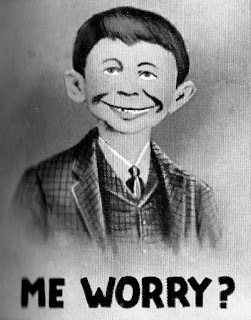 Original postcard image of the Idiot Kid.Alfred E. Neuman's original likeness was found in 1954 on an old postcard with the caption "ME WORRY?" by editor Harvey Kurtzman. The image of the "idiot kid" and his never-may care attitude stuck with Kurtzman. He asked master artist Norman Mingo to punch up the artwork with some minor details. Kurtzman also decided to change the motto slightly. Now it read "What, Me Worry?" Being a parody magazine made the blatant plagiarism less onerous one supposes.
Original postcard image of the Idiot Kid.Alfred E. Neuman's original likeness was found in 1954 on an old postcard with the caption "ME WORRY?" by editor Harvey Kurtzman. The image of the "idiot kid" and his never-may care attitude stuck with Kurtzman. He asked master artist Norman Mingo to punch up the artwork with some minor details. Kurtzman also decided to change the motto slightly. Now it read "What, Me Worry?" Being a parody magazine made the blatant plagiarism less onerous one supposes.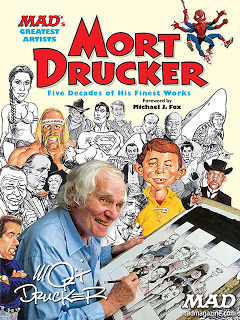 Alfred E. Neuman's official cover debut was in 1956 as a write-in candidate for president. In the interest of full disclosure, Dwight David Eisenhower won that race, but Neuman became MAD's mascot and official trademark. The idiot kid with a head shaped like home plate, misaligned eyes, big ears, and gap-toothed smile was so iconic that once a letter bearing only Neuman's image without an address was delivered to MAD's offices on Madison Avenue in Manhattan.
Alfred E. Neuman's official cover debut was in 1956 as a write-in candidate for president. In the interest of full disclosure, Dwight David Eisenhower won that race, but Neuman became MAD's mascot and official trademark. The idiot kid with a head shaped like home plate, misaligned eyes, big ears, and gap-toothed smile was so iconic that once a letter bearing only Neuman's image without an address was delivered to MAD's offices on Madison Avenue in Manhattan.MAD magazine shut down in April 2018. Times have changed and the magazine lost its audience to more modern forms of media entertainment. I'm gonna miss that idiot kid.
Ten Things the Comics Code Authority Banned
September 4, 2020
Detroit Boxer Joe Louis's Place in American History
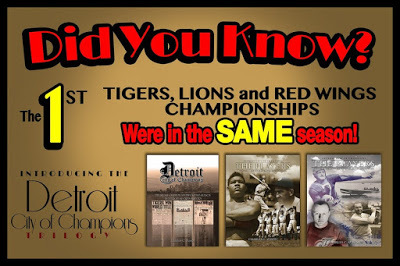
During the height of the Great Depression in the 1935-1936 sports season, Detroit's professional sports teams accomplished a feat unrivaled in American sports history. The Detroit Lions, the Detroit Tigers, and the Detroit Red Wings all won their championships the same year. The season was called by the Windsor Star "...the most amazing sweep of sports achievement ever credited to any single city." That prompted Michigan Governor Frank Fitzgerald to proclaim and designate April 18th, 1936 as "Champions Day" in Michigan. Champions throughout the state were honored.
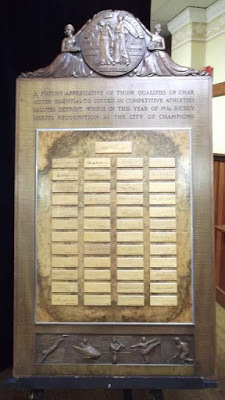 The White House honored Detroit as the "City of Champions" in 1936 presenting the city with a wooden plaque signed by President Franklin Roosevelt and the forty-eight sitting governors. The plaque included five medallions at the bottom representing the Tigers, Lions, Red Wings, and standout individuals speedboat racer Gar Wood for winning the international Harmsworth Trophy and boxer Joe Louis for bursting onto the national boxing scene after a successful amateur career. The plaque was presented at a banquet on July 16th in Traverse City during the 1936 Cherry Festival.
The White House honored Detroit as the "City of Champions" in 1936 presenting the city with a wooden plaque signed by President Franklin Roosevelt and the forty-eight sitting governors. The plaque included five medallions at the bottom representing the Tigers, Lions, Red Wings, and standout individuals speedboat racer Gar Wood for winning the international Harmsworth Trophy and boxer Joe Louis for bursting onto the national boxing scene after a successful amateur career. The plaque was presented at a banquet on July 16th in Traverse City during the 1936 Cherry Festival. Locally, a banquet was held in Detroit attended by over 600 fans at the Masonic Temple with the event broadcast over WXYZ radio. Many of the athletes from the sports teams gave speeches, however, Joe Louis did not speak because Louis lost a heavyweight championship fight to German Max Schmeling later that year. His boxing medallion was removed and replaced by a diver representing Amature Athletic Union (AAU) high dive champion Dirk Degener. Anyone remember Dirk? I didn't think so.
***
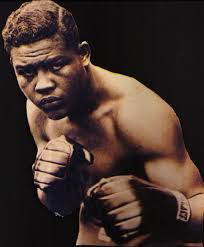
Joseph Louis Barrow was best known as the "Brown Bomber." He boxed from 1934 until 1951 and reigned as heavyweight champion from 1937 to 1949. Joe was born in Chambers County, Alabama--the seventh of eight children. Both of his parents were children of former slaves.
Louis's family moved to Detroit after a brush with the Ku Klux Klan when Joe was twelve. The Louis family was part of the Great Migration after World War I. His family settled on 2700 Catherine Street in the now defunct neighborhood of Black Bottom. When old enough, Joe and his older brother worked at the Rouge Plant for the Ford Motor Company.
During the Great Depression, Joe spent time at a local youth recreation center at 637 Brewster Street in Detroit and made his boxing debut early in 1932 at the age of seventeen. In 1933, Louis won the Detroit-area Golden Gloves Novice Division. In 1934, he won the Chicago Golden Gloves championship and later that year became the United States Amateur Champion in a national AAU tournament in St. Louis, Missouri. By the summer of 1934, Joe had gone pro with a management team.
In 1936, Louis got a title shot versus world heavyweight champion Max Schmeling in Yankee Stadium. The German trained hard while Louis seemed more interested in his golf game--his new hobby. Schmeling knocked Louis out in the 12th round handing Joe his first professional loss. Schmeling became a national hero in Nazi Germany as an example of Aryan superiority.
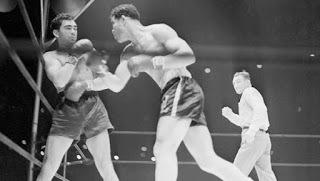 Max Schmeling and Joe Louis rematch.No path to a rematch was open to Louis until June 22, 1938. Louis and Schmeling met for a second time at Yankee Stadium before a crowd of 70,043. The fight was broadcast worldwide in English, German, Spanish, and Portuguese. It should be noted that Max Schmeling was not a Nazi, but the Nazi party propaganda minister Joseph Goebbels hyped the match proclaiming a black man could not defeat Herr Schmeling.
Max Schmeling and Joe Louis rematch.No path to a rematch was open to Louis until June 22, 1938. Louis and Schmeling met for a second time at Yankee Stadium before a crowd of 70,043. The fight was broadcast worldwide in English, German, Spanish, and Portuguese. It should be noted that Max Schmeling was not a Nazi, but the Nazi party propaganda minister Joseph Goebbels hyped the match proclaiming a black man could not defeat Herr Schmeling.The American press promoted the match as an epic battle between Nazi ideology and American democratic ideals. Louis became the embodiment of anti-Nazi sentiment. After the big media buildup, the fight lasted only two minutes and four seconds. Schmeling went down three times before his trainer threw in the towel ending the match. For the first time in American history, every black person and white person in the country celebrated the same event at the same time. Not until the end of World War II would that happen again.
Joe Louis became the first African-American national hero. He reigned as heavyweight champion from 1937 until 1949--longer than anyone else. In 1951, Louis was beaten by Rocky Marciano and retired from the ring. The following year, he was responsible for breaking the color line integrating the game of golf. He appeared as a celebrity golfer under a sponsor's exemption at a PGA event in 1952. How many people know that?
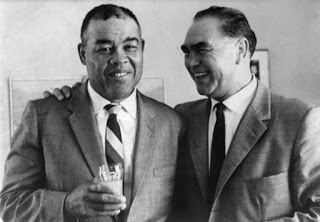 Joe Louis and Max SchmelingJoe Louis died on April 12, 1981 of cardiac arrest at the age of sixty-six in Desert Springs Hospital near Las Vegas after a public appearance at the Larry Holmes-Trevor Berbick heavyweight battle. President Ronald Reagan waived eligibility rules for Joe Louis to be buried at Arlington National Cemetery with full military honors on April 21st. His funeral was paid for by his friend Max Schmeling, who also acted as a pallbearer.
Joe Louis and Max SchmelingJoe Louis died on April 12, 1981 of cardiac arrest at the age of sixty-six in Desert Springs Hospital near Las Vegas after a public appearance at the Larry Holmes-Trevor Berbick heavyweight battle. President Ronald Reagan waived eligibility rules for Joe Louis to be buried at Arlington National Cemetery with full military honors on April 21st. His funeral was paid for by his friend Max Schmeling, who also acted as a pallbearer.In his professional boxing career, Joe Louis won virtually every boxing award there is and was awarded the Congressional Gold Medal posthumously in 1982. The City of Detroit honored Joe Louis with a monument on October 16, 1989. When drivers look left at Woodward Avenue from Jefferson Avenue (now a No Left Turn), they are confronted with a colossal fist and forearm suspended from a triangular superstructure--a testament to the regard and respect Detroiters hold for their hometown hero.
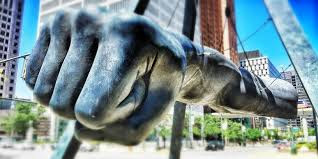
Link to the Joe Louis/Max Schmeling 1937 heavyweight fight
https://www.youtube.com/watch?v=2LNzWHuygpw
August 26, 2020
Connie Kalitta "The Bounty Hunter" vs. Shirley "Cha-Cha" Muldowney
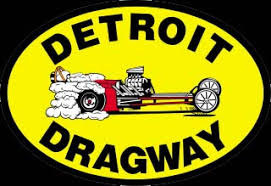
Baby Boomers who grew up in the Detroit area and listened to Windsor radio station CKLW were familiar with advertisements for the Detroit Dragway located at Sibley and Dix. The ads always began with "Saturday, SATURDAY NIGHT, at the DETROIT DRAGWAY." Then the card for the automotive duels would be hyped. If you don't remember or aren't old enough to know what I'm talking about, I have a link to an audio at the end of this post.
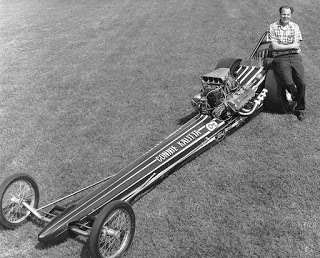 Connie Kalitta with top fuel dragster in 1967.Two of the most popular drag racers of the 1970s and 1980s were Connie Kalitta "The Bounty Hunter" and Shirley "Cha-Cha" Muldowney. Connie was from Mount Clemens, Michigan, and Shirley was from Schenectady, New York. They shared a professional and personal relationship from 1972-1977. Connie gave Shirley a Funny Car he no longer raced, and he acted as her crew chief for many of her early races. In those days, Shirley was known as "The Huntress."
Connie Kalitta with top fuel dragster in 1967.Two of the most popular drag racers of the 1970s and 1980s were Connie Kalitta "The Bounty Hunter" and Shirley "Cha-Cha" Muldowney. Connie was from Mount Clemens, Michigan, and Shirley was from Schenectady, New York. They shared a professional and personal relationship from 1972-1977. Connie gave Shirley a Funny Car he no longer raced, and he acted as her crew chief for many of her early races. In those days, Shirley was known as "The Huntress." Kalitta began drag racing when he was a sixteen-year-old student at Mount Clemens High School. He worked himself up the ranks of the National Hot Rod Association (NHRA) to become one of the sport's top drivers. Known as The Bounty Hunter, Kalitta was the first driver to reach 200 mph in a sanctioned NHRA event. In 1989 at the Winter Nationals, Kalitta was the first driver to break the 290 mph barrier with a 291.54 mph qualifying run.
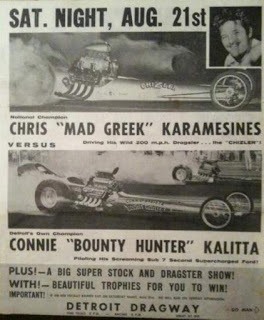 In all, Kalitta won ten national titles and was inducted into the Motorsports Hall of Fame of America in 1992. The NHRA compiled a list of the Top 50 Drivers for their fiftieth-anniversary in 2001. Kalitta ranked 21st on the all-time list, and in 2016, he became the first recipient of the NHRA's Lifetime Achievement Award.
In all, Kalitta won ten national titles and was inducted into the Motorsports Hall of Fame of America in 1992. The NHRA compiled a list of the Top 50 Drivers for their fiftieth-anniversary in 2001. Kalitta ranked 21st on the all-time list, and in 2016, he became the first recipient of the NHRA's Lifetime Achievement Award. Kalitta's first NHRA win came in 1964 in Bakersfield, California. In 1967, he won his first NHRA title. With the prize money, he bought his first airplane--a Cessna 310--and started his company Kalitta Air at the Willow Run Airport shipping freight for the Ford Motor Company (FoMoCo)--his racing sponsor.
 Kalitta Air and Kalitta Motorsports company photograph.For a time, Kalitta retired from racing and directed his attention toward building up his air freight business. Now he has a fleet of about 100 planes, many of them 747s. In addition to a bread-and-butter FoMoCo parts distribution contract, Kalitta Air provides charter flights for Medical Flight Services, Air Ambulance Specialists, the Shriners' Children's Hospital and the United States Department of Defense, to name a few. It is not generally known that Kalitta Air keeps a 747 on standby to work with the military to return fallen service men and women to their homes.
Kalitta Air and Kalitta Motorsports company photograph.For a time, Kalitta retired from racing and directed his attention toward building up his air freight business. Now he has a fleet of about 100 planes, many of them 747s. In addition to a bread-and-butter FoMoCo parts distribution contract, Kalitta Air provides charter flights for Medical Flight Services, Air Ambulance Specialists, the Shriners' Children's Hospital and the United States Department of Defense, to name a few. It is not generally known that Kalitta Air keeps a 747 on standby to work with the military to return fallen service men and women to their homes.Kalitta no longer races, but he is the CEO of Kalitta Motorsports in Ypsilanti, Michigan which sponsors four cars and drivers. His love of racing became a lifelong pursuit and a way of life.
***
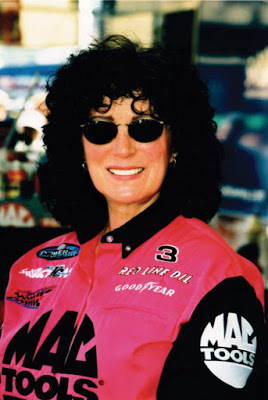 Shirley MuldowneyConnie Katilla first met Shirley Muldowney in 1966 at Raceway Park in Illinois when she was racing a dragster with her husband as her mechanic. In 1972, Shirley divorced Jack Muldowney when she wanted to advance to top fuel funny cars, and he refused to live the life of a Gypsy to compete on the NHRA circuit. Doubtless, there were other personal issues as Shirley moved in with Kalitta in 1972.Kalitta was The Bounty Hunter and Muldowney became The Huntress. Connie soon tagged Shirley with the nickname "Cha-Cha" which she never liked, but it became part of her NHRA branding.
Shirley MuldowneyConnie Katilla first met Shirley Muldowney in 1966 at Raceway Park in Illinois when she was racing a dragster with her husband as her mechanic. In 1972, Shirley divorced Jack Muldowney when she wanted to advance to top fuel funny cars, and he refused to live the life of a Gypsy to compete on the NHRA circuit. Doubtless, there were other personal issues as Shirley moved in with Kalitta in 1972.Kalitta was The Bounty Hunter and Muldowney became The Huntress. Connie soon tagged Shirley with the nickname "Cha-Cha" which she never liked, but it became part of her NHRA branding.After her split from Kalitta, Shirley went on to make a name for herself in this macho male sport. At first, she had trouble attracting sponsors and finding a crew that would work with a woman. But when Shirley "Cha-Cha" Muldowney showed up at the track with her hot pink car, cowboy boots, and crash helmet, she started filling the grandstands. Even her pit crew wore hot pink team shirts.
 Muldowney defied traditional gender stereotypes head-on and challenged sexism in the racing culture like Billie Jean King had for tennis in 1973's Battle of the Sexes against Bobby Riggs. Both ladies proved women can compete in a man's world.
Muldowney defied traditional gender stereotypes head-on and challenged sexism in the racing culture like Billie Jean King had for tennis in 1973's Battle of the Sexes against Bobby Riggs. Both ladies proved women can compete in a man's world.Shirley Muldowney was the first woman to receive a NHRA license to drive top fuel dragsters. She was the first person--man or woman--to win three NHRA national events in a row. In 1980, Shirley won the World Finals by beating her nemesis Connie Kalitta, and in 1982, she won an unprecedented third NHRA Top Fuel Championship.
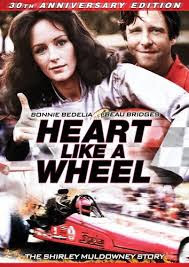 Muldowney's achievements were not lost on Hollywood. She got the big screen treatment in 1983's Heart Like a Wheel starring Bonnie Bedelia as Muldowney and Beau Bridges as Connie Kalitta. Muldowney has said the film didn't capture her real life very well but was good for the sport.
Muldowney's achievements were not lost on Hollywood. She got the big screen treatment in 1983's Heart Like a Wheel starring Bonnie Bedelia as Muldowney and Beau Bridges as Connie Kalitta. Muldowney has said the film didn't capture her real life very well but was good for the sport.On the heels of her celebrity, Muldowney was faced with her biggest challenge. In June of 1984, her dragster crashed at over 250 mph at Sanair Speedway near Montreal, Canada. A front tire shredded and got twisted up in a wheel causing the car to lose control for 600 feet before crashing. Shirley was left with broken legs, crushed hands, a shattered pelvis, and a severed thumb. Determined to race again, she undertook two years of grueling physical therapy and recovery. Her first race back was against "Big Daddy" Don Garlits--a personal friend of hers. She lost.
Because of trouble attracting sponsors, Shirley retired from racing in 2003. During her career, she won eighteen NHRA National events and was ranked 5th on NHRA's 2001 list of its Top 50 Drivers earning her the title of "First Lady of Drag Racing." Her memoir Shirley Muldowney: Tales from the Track was released in 2005 depicting her drag racing life. The same year, Muldowney was inducted into the Automotive Hall of Fame.
*** CKLW radio commercial for the Detroit Dragway from 1966: https://www.youtube.com/watch?v=BbrdImfvFmQ
1982 U.S. Nationals Championship drag race between Kalitta and Muldowney: https://www.youtube.com/watch?v=2-Q8f6bsfI0
Muldowney on the Johnny Carson Show in 1986 after her 1984 catastrophic car crash: https://www.youtube.com/watch?v=1FeaqiczHzI
August 23, 2020
Alex Karras’ Made-In-Detroit Movie—Jimmy B. and Andre (1980)
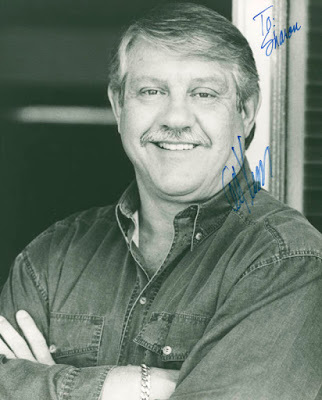 Alex Karras proves there is life after professional football.
Alex Karras proves there is life after professional football.When Alex Karras retired from the Detroit Lions in 1970, he left town for the bright lights of Hollywood. Alex first caught the acting bug as a senior at Emerson High School in Gary, Indiana when he performed in South Pacific. When he played college football at the University of Iowa, Karras wrestled professionally as villain George Brown donning a full mask and earning $50 a match. He relished playing the bad guy and acting crazy. It beat working in the steel mills.
After Karras was drafted by the Detroit Lions, he supplemented his ridiculously low NFL salary by wrestling in the off-season to help pay the bills for his growing family. He formed a tag team called Killer Karras and Krusher Konovski that performed to boos and sneers while winning all of their matches in the Midwest. While still a Detroit Lion, Karras played himself in the Hollywood film, Paper Lion. He garnered good reviews that led him to pursue an acting career.
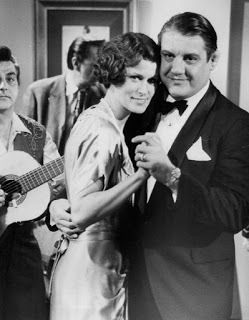 Karras with Susan Clark in BABE.Karras cut his teeth on several minor roles before he landed a co-star role in The Babe Didrikson Zaharias Story with actress Susan Clark, who won a best-actress Emmy for her excellent performance. They began performing regularly together and eventually married. In 1979, they jointly formed a Hollywood production company named Georgian Bay Productions.
Karras with Susan Clark in BABE.Karras cut his teeth on several minor roles before he landed a co-star role in The Babe Didrikson Zaharias Story with actress Susan Clark, who won a best-actress Emmy for her excellent performance. They began performing regularly together and eventually married. In 1979, they jointly formed a Hollywood production company named Georgian Bay Productions. Their first full length movie project was Jimmy B. and Andre which debuted on CBS on March 19, 1980. It was based on the true story of Jimmy Butsicaris, co-owner with his brother Johnny of the popular Lindell AC (Athletic Club) sports bar. The Lindell AC was frequented by Detroit Lion and Tiger athletes, sports writers, and sports fans from every level of Detroit society. Alex wanted to make a made-for-TV movie about his friend Jimmy B. trying to adopt a nine-year-old, African-American street kid named Andre Reynolds.
Andre was an elementary school dropout who shined shoes at Jim’s barber shop next door to the Lindel AC to pick up some extra money. But an older, local bully named Billy began harassing Andre for his hard-earned cash. Jimmy Butsicaris rescued the ragged, nine-year-old Andre from a beating one afternoon, finding him in desperate need of a bath, a meal, and some guidance. Over a cheese burger, fries, and a Coke, Jimmy learned the boy’s story. Andre’s mother was a widow who was also a heroin addict in poor health. Much of the money Andre turned over to her ended up in her arm. There was also an older sister and brother in the household.
Jimmy took the kid under his wing and gave him work doing odd jobs and a place to stay in the basement storeroom of the bar. Johnny Butsicaris converted a photo darkroom into a safe place for Andre to stay. He lived there for nine years. After the death of Andre’s mother from an overdose, Jimmy tried to adopt Andre but ran into trouble with the boy’s aunt who wanted him and his siblings as dependents to earn extra welfare money.
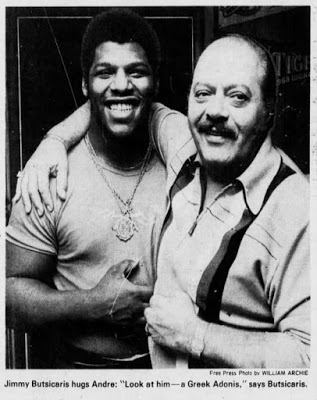 Detroit Free Press - March 20, 1980.Undeterred by the court’s decision to deny him guardianship, Jimmy became Andre’s foster father and treated him like a son. As Andre grew into manhood, he called Jimmy “Pop.” To show his appreciation, Andre had a shirt made that read “I Am a Black Greek.” Jimmy took Andre to Detroit Lion and Tiger games and introduced him everywhere as his son. Jimmy helped Andre get back in public school where he earned a high school diploma from Western High School when he was twenty years old.
Detroit Free Press - March 20, 1980.Undeterred by the court’s decision to deny him guardianship, Jimmy became Andre’s foster father and treated him like a son. As Andre grew into manhood, he called Jimmy “Pop.” To show his appreciation, Andre had a shirt made that read “I Am a Black Greek.” Jimmy took Andre to Detroit Lion and Tiger games and introduced him everywhere as his son. Jimmy helped Andre get back in public school where he earned a high school diploma from Western High School when he was twenty years old. In the meantime, Karras and Clark pitched their story idea to CBS and sold them on it. Karras portrayed his friend Jimmy Butsicaris as a gruff restaurant owner with a big heart, and Susan Clark played his long-suffering girlfriend Stevie. In the movie, Jimmy keeps finding reasons not to marry her. Karras’ son, Alex Karras Jr, played a cameo role as the bully who beats up the young Andre, the real Andre played a restaurant employee called Bubba, and local Detroit weatherman Sonny Eliot played a drunk in the movie.
The movie project was shot entirely in Detroit at the Lindell AC, Jim’s Barber Shop next door, the Greektown restaurant district downtown, Belle Isle Park, and the Renaissance Center. The film was notable because of the heart-rending performance of twelve-year-old Curtis Yates, a student at Country Day School in Birmingham, Michigan. The real Andre Reynolds said he cried every time he saw the movie about his life and his foster father Jimmy Butsicaris.
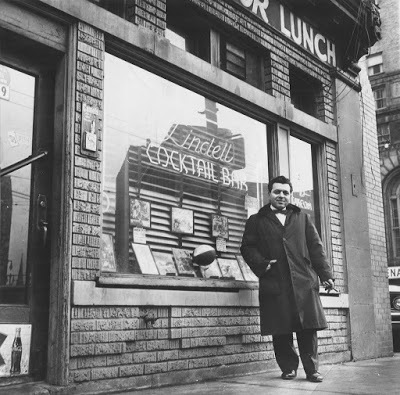 Johnny Butsicaris in front of the Lindell AC sports bar.
Johnny Butsicaris in front of the Lindell AC sports bar. After Andre’s high school graduation, Jimmy urged him to attend Grand Rapids Community College where he played football for one semester, but at 5’ 9” and 185#, Andre wasn’t big enough for college ball, so he dropped out. When Andre returned to Detroit, he left the influence of his mentor and drifted into Detroit’s drug culture. When he was busted for possession and drug trafficking, Andre served his sentence in Marquette Branch Prison.
In a prison cell at Marquette Branch Prison in Michigan’s Upper Peninsula on November 21, 1996, thirty-six-year-old Andre learned that his foster father and mentor Jimmy Butsicaris had died the evening before at the age of seventy-five from a massive heart attack. Reynolds wasn’t eligible for parole, so he couldn’t attend the funeral, but he agreed to be interviewed by Detroit News reporter Thomas BeVier.
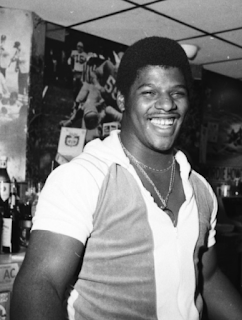 Andre Reynolds at Lindell AC in 1979.“(Jimmy) Butsicaris took me in when I was a nine-year-old, punk kid living in a drug infested environment. I had a few moments of fame when the movie Jimmy B. and Andrecame out. I was nineteen and wanted to be an adult, but I didn’t know how to do that. I was paid $15,000 for my story, and I used it to buy two cars and go to Grand Rapids Community College. But along the way, I fell in with a rough crowd and was in and out of trouble most of my twenties. I’m ashamed of the life I’ve lived.”
Andre Reynolds at Lindell AC in 1979.“(Jimmy) Butsicaris took me in when I was a nine-year-old, punk kid living in a drug infested environment. I had a few moments of fame when the movie Jimmy B. and Andrecame out. I was nineteen and wanted to be an adult, but I didn’t know how to do that. I was paid $15,000 for my story, and I used it to buy two cars and go to Grand Rapids Community College. But along the way, I fell in with a rough crowd and was in and out of trouble most of my twenties. I’m ashamed of the life I’ve lived.” Andre served his sentence and was released. A few days before Thanksgiving in 2000, Andre Reynolds was brutally attacked by an unknown person or persons who beat and stomped him mercilessly. Detroit Police posited that Andre ran afoul of a local drug gang, but no charges were ever brought in his murder. He spent his final days in a coma at Detroit’s Receiving Hospital before succumbing. His body was unidentified in the Wayne County Morgue for four days before he was buried. What seemed on screen like a promising future for Andre became a nightmare in real life.
Alex Karras filmfest
August 11, 2020
Danse Macabre (The Dance of the Dead)
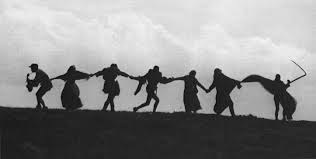 Climax of Igmar Bergman's film The Seventh Seal.
Climax of Igmar Bergman's film The Seventh Seal.The Danse Macabre was a religious allegory of the late Middle Ages calculated to turn men's thoughts to a Christian preparation for death. It was a reaction to the horrors of the 14th century's recurring famines, the Hundred Year War in France, and the scourge of the Black Death (plague). Millions of Europeans persished during this period. Estimates run as high as 50 million people or 60% of the population.
Produced by the church fathers as a "memento mori" to remind people that all human life is fragile and life's petty pleasures are fleeting, the Danse Macabre summons people from all stages and walks of life whether pope or layman, young or old, male or female, rich or poor. The universality of death is the great leveler that unites all.
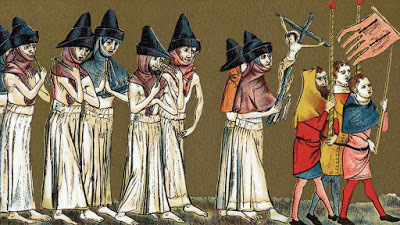 Dutch Flagellants scourging themselves as penance.
Dutch Flagellants scourging themselves as penance.The spectre of sudden death during this period of history increased the religious practice of saying penance and/or self-flagellation (whipping) by the faithful, but it also created a secular desire for amusement and diversion while people could still enjoy life's creature comforts. This expression of the struggle between the sacred and the profane played itself out in medieval society.
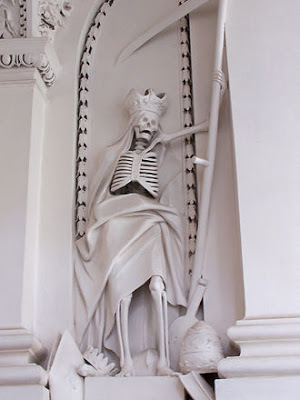 Outside of St. Peter and St. Paul Church in Lithuania.Many paintings, book illustrations, and sculptures were commissioned by the Catholic Church to act as penitential lessons that even the illiterate majority could understand. Cathedrals often portrayed danse macabre images in sculptures adorning their exterior architecture.
Outside of St. Peter and St. Paul Church in Lithuania.Many paintings, book illustrations, and sculptures were commissioned by the Catholic Church to act as penitential lessons that even the illiterate majority could understand. Cathedrals often portrayed danse macabre images in sculptures adorning their exterior architecture.The medieval morality play called The Summoning of Everyman was first performed in 1510 in front of church entrances to draw in the crowd. In the play, Everyman uses every argument he can to avoid his impending death before he gives up and seeks out the sacrament of the Last Rites. Only his good deeds go with him to the grave--a sober reminder to the faithful that worldly goods count for nothing in the next world.
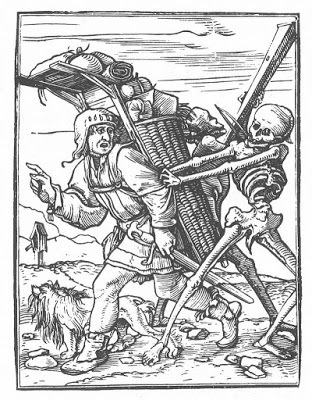 The Pedlar from Hans Holbein's "Figure de la Morte." The pedlar seems to say, "I'm busy. Gotta run!" Death replies, "Not this day!"
The Pedlar from Hans Holbein's "Figure de la Morte." The pedlar seems to say, "I'm busy. Gotta run!" Death replies, "Not this day!"Hans Holbein, the Younger created a series of forty-one woodcuts between 1523-1526 depicting the danse macabre morality tale. His work broadened the concept from its Catholic and Protestant origins into a more secular interpretation which eventually became the inspiration for Halloween.
On All Hallow's Eve (shortened to Halloween), the medieval Catholic church promoted the idea that the veil between the material world and the afterlife lifted. Annual harvest celebrations and village pageants drew revellers wearing masks and costumes dressed as corpses representing all strata of society. After a night of feasting and celebrating, a procession was led by priests to the church graveyard at midnight to lay flowers, leave votive candles, and pray for the souls of the dearly departed in preparation for fasting on All Saint's Day.
In Edgar Allen Poe's short story The Masque of the Red Death written in 1842, medieval Prince Prospero and his wealthy and influential friends attempt to outsmart Death during the plague by hiding out in the prince's abbey. The results are predictable and serve as a cautionary tale for our own time as we struggle with the corona virus and the predictability of human behavior.
Poe's Masque of the Red Death with notes.
August 6, 2020
Terror In Ypsilanti Pilot in the Works
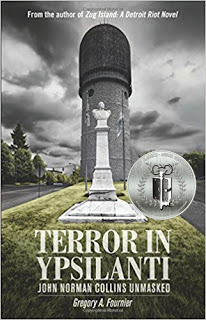 Available in softcover, ebook, and audio.I received some good news in June that a Canadian media company I signed with in 2019 recently hired two women writers to develop a screenplay for Terror In Ypsilanti. They are working on a pilot as part of a package to promote a possible six-part miniseries to producers. This recent development is by no means a done deal, but it did raise my spirits when the doldrums of this pandemic were beginning to wear on me, so I thought I would share the news.
Available in softcover, ebook, and audio.I received some good news in June that a Canadian media company I signed with in 2019 recently hired two women writers to develop a screenplay for Terror In Ypsilanti. They are working on a pilot as part of a package to promote a possible six-part miniseries to producers. This recent development is by no means a done deal, but it did raise my spirits when the doldrums of this pandemic were beginning to wear on me, so I thought I would share the news.Longtime residents of Ypsilanti, Michigan may remember when a film crew from New York City rolled into town early in 1977 with Hollywood producer, director, and writer William Martin to film a movie about the Washtenaw County murders of 1967-1969.
Eastern Michigan University (EMU) freshman Karen Sue Beineman went missing on July 23, 1969 when she was last seen riding on the back of a motorcycle with a young, white male wearing a green and yellow striped soccer jersey and shorts. EMU senior John Norman Collins was arrested a week later. It was generally believed by authorities that Collins was the same person who had murdered six other young women in the area. It would be a year before the Beineman case went to trial in Ann Arbor, Michigan.
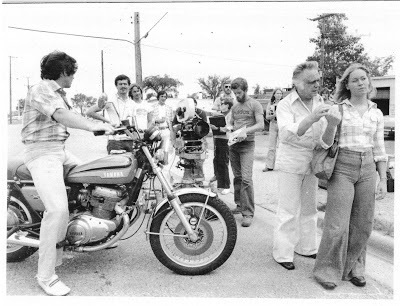 Actor Robert Purvey on motorcycle and William Martin directing local actor Kathy Pierce.William Martin's movie about the murders was named after the children's bedtime prayer Now I Lay Me Down To Sleep. The production ran into trouble from the start. The first strike against it was Martin's script; he didn't have one. He filmed short segments without the cast on set or any predetermined locations. Martin was filming the establishing, exterior shots before the Hollywood studio work, he said.
Actor Robert Purvey on motorcycle and William Martin directing local actor Kathy Pierce.William Martin's movie about the murders was named after the children's bedtime prayer Now I Lay Me Down To Sleep. The production ran into trouble from the start. The first strike against it was Martin's script; he didn't have one. He filmed short segments without the cast on set or any predetermined locations. Martin was filming the establishing, exterior shots before the Hollywood studio work, he said.The second strike was that William Martin was an alias for Teamster organizer Martin Bacow, who reincarnated himself in Hollywood when he was the Teamster's man in Tinsel Town. His only other film credit was something called Jacktown about the 1952 Jackson Prison riot, which was so bad it was never released.
The third strike against the project was when Martin/Bacow was subpoenaed to testify in Detroit Federal Court as a material witness regarding Jimmy Hoffa's disappearance. That's the last time the film crew saw or heard from William Martin. They packed up their rented equipment and returned to New York. This movie was never produced, nor does a single bit of film footage exist. The enterprise amounted to a scam to defraud investors. More on that story is in the link at the end of this post.
My initial glee upon hearing about a possible Terror In Ypsilanti movie project is tempered by the seriousness of the subject matter. One of the standard provisions in my contract was signing away creative control. But the CEO of the media company asked if I'd be interested being a script consultant. Well, of course I would.
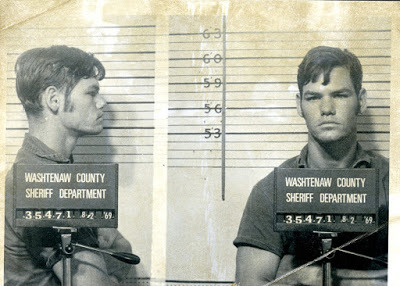 Original mugshot--August 2, 1969.
Original mugshot--August 2, 1969.One concern I have about the project is how John Norman Collins will be portrayed. He drives the plot, but I feel he should remain a murky, anonymous figure throughout most of the series until he is unmasked towards the end. Rather than tell the story through his eyes, the screenplay writers are motivated to tell this story through the point of view of the victims, with a feminine sensibility rare in the true crime genre.
The Ann Arbor and Detroit media sensationalized this tragedy and intimated that the victims were somehow responsibile for their own demise. Perhaps this attitude relected the media's need to make a morality tale out of this tragedy, but collateral harm was done to their friends and families. Times have changed in fifty years, so it is my belief that these portrayals will be more respectful.
Another concern I have is how Ypsilanti will be portrayed. The city was deeply affected by this tragedy and that story needs to be told with sensitivity too. I hope some of the exteriors for the movie will be filmed in Ypsilanti to give the project an authentic look and feel.
Undoubtedly, some people will find the project repugnant and won't be happy whatever the outcome of the film. I already know one person in Marquette Branch Prison who won't be pleased. I expect this project to take several years before it is ready for prime time, but I'm optimistic it will come to pass, unlike the Now I Lay Me Down to Sleep fiasco. Hope I live long enough to see it.
Whatever happened to Now I Lay Me Down To Sleep?
July 28, 2020
Broadcast Television vs. Cable Systems
 In 1907, Russian Boris Rosing and Englishman A.A. Campbell-Swinton combined a cathode ray tube with a mechanical scanning system to create a rudimentary electronic image. It wasn't until 1927 that twenty-one-year-old American inventor Philo Farnsworth invented the first television system with a transmitter that sent electronic coded images over the airwaves to a receiver which decoded the signals into light and dark. Black and white television was born.
In 1907, Russian Boris Rosing and Englishman A.A. Campbell-Swinton combined a cathode ray tube with a mechanical scanning system to create a rudimentary electronic image. It wasn't until 1927 that twenty-one-year-old American inventor Philo Farnsworth invented the first television system with a transmitter that sent electronic coded images over the airwaves to a receiver which decoded the signals into light and dark. Black and white television was born.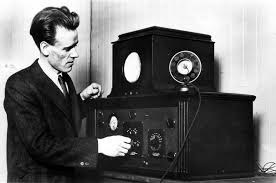 Philo Farnsworth--with invention.
Philo Farnsworth--with invention.Legend has it that when Farnsworth pitched his invention to potential investors, one of them asked him when they might see some dollars out of this thing. Thinking quickly, Fransworth televised the image of a dollar bill. Investment was there, but the Depression and World War II put commercial television production on hold. RADAR, SONAR, and information processing research took precedence over consumer televison until war's end.
The miracle of television was brought to our homes via tall broadcast towers that sent electromagnetic signals over the airwaves carrying TV programming to rooftop antennas connected to our television sets in our living rooms. The first broadcast stations in 1946 had limited broadcast hours. Hollywood Westerns dominated early programming. By 1949, most American urban centers had at least one station; by 1953, half of all American households had a television set; and by 1956, most United States cities were linked to network programming.
Broadcast signals weakened the further away from the transmitter towers. Mountains and weather could interfer with a station's reach. The national broadcasters (NBC, CBS, and ABC) needed to reach the largest number of viewers, so they concentrated on densely populated urban areas leaving people in rural or outlying areas with a weak signal or no signal at all. Cable TV began in 1948 to address the problem of providing outlying areas with an improved signal.
 Coaxial cableRobert J. Tarlton is credited by many as developing the first cable TV operation. He parlayed his Army radio communications training into opening an electronics store in Lansford, Pennsylvania after the war. Nobody in town was interested in buying a TV from him because a mountain blocked the signal from Philadelphia sixty-five miles away. Tarlton convinced some investors to build large antennas on top of the mountain in 1949. These antennas channeled the weak signals from Philadelphia, fed them into coaxial cables, amplified them, and carried the strengthened electronic signals to decoder boxes--all for a one-time $125 installation charge and $3 monthly cable box fee.
Coaxial cableRobert J. Tarlton is credited by many as developing the first cable TV operation. He parlayed his Army radio communications training into opening an electronics store in Lansford, Pennsylvania after the war. Nobody in town was interested in buying a TV from him because a mountain blocked the signal from Philadelphia sixty-five miles away. Tarlton convinced some investors to build large antennas on top of the mountain in 1949. These antennas channeled the weak signals from Philadelphia, fed them into coaxial cables, amplified them, and carried the strengthened electronic signals to decoder boxes--all for a one-time $125 installation charge and $3 monthly cable box fee.Cable Antenna Television (CATV) was an immediate success but its expansion was limited until sufficient infrastructure was in place. In 1950, there were 70 cable systems across rural America, but by the 1960s, there were 640 systems. The growth of cable TV threatened the network broadcasting cartel that believed cable providers were thieves stealing their product and making a profit from it. For the next thirty years, cable TV was restricted by the FCC--at the behest of the national networks--to show only existing network programming thereby eliminating competition.
In 1962, the FCC asserted its authority over cable because of its potential negative impact on broadcast television. Their regulations limited cable TV systems to small local markets inhibiting their growth again to protect the networks from competition. In 1969, the FCC forbade cable systems from showing movies under ten years old or televising sporting events under five years old.
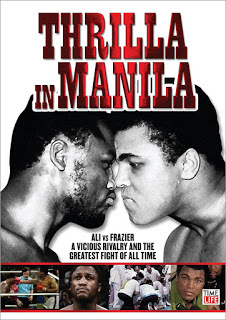
The game changed in 1975 when the FCC allowed orbiting satellites to broadcast television signals. Small start-up media company, Home Box Office (HBO) began distributing its limited programming nationwide via satellite. Then on October 1, 1975, HBO broadcast the first pay-per-view program--The Thrilla from Manila--a world heavyweight boxing title match between Muhammad Ali and Smokin' Joe Frazier broadcast worldwide live from the Phillipines. The global success and financial windfall prompted HBO to file a lawsuit against the FCC. In 1977, the federal court in Washington, DC ruled that the FCC was not justified in restricting cable televison's development.
The nation's cable operators gained the right to air recent movies and live sporting events. More importantly, the cable industry was free to develop specialty channels with original programming targeted at smaller, niche audiences.
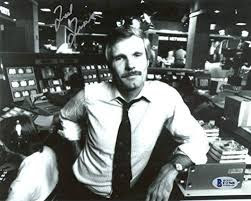 Ted TurnerEntrepreneur Ted Turner transformed his small Atlanta cable operation into a national cable network in 1976. WTBS was dubbed America's First Superstation and in 1978 WGN from Chicago also went national. In 1979, the Entertainment Sports Programming Network (ESPN) quickly grew into a multi-billion-dollar media giant leaving its imprint on American sports culture. A revolution in television news expanded the media universe with Ted Turner's Cable News Network (CNN) in 1980, and Music Television (MTV) exploded onto the scene in 1981 focusing on the new medium of music videos.
Ted TurnerEntrepreneur Ted Turner transformed his small Atlanta cable operation into a national cable network in 1976. WTBS was dubbed America's First Superstation and in 1978 WGN from Chicago also went national. In 1979, the Entertainment Sports Programming Network (ESPN) quickly grew into a multi-billion-dollar media giant leaving its imprint on American sports culture. A revolution in television news expanded the media universe with Ted Turner's Cable News Network (CNN) in 1980, and Music Television (MTV) exploded onto the scene in 1981 focusing on the new medium of music videos.The Cable Communications Policy Act of 1984 completely deregulated the cable industry. Today, the cable industry has over 900 programming networks available to 93% of American households. The industry supports more than three million, well-paying jobs. In the 2000s, it remains to be seen if cable TV can survive a new era of competition from streaming services like Netflix and Amazon Prime. Will the American consumer cut the cord? In an industry that thrives on innovation, only time and the marketplace will tell.
Origin of the Limelight.
June 19, 2020
The Mackinac Bridge--Michigan's Most Valuable Asset

If people needed to cross the four mile Straits of Mackinac between Michigan's Lower and Upper Peninsulas before 1957, they went either by boat or chartered plane. In 1923, the state legislature instituted ferry boat services for cars and trucks. The phenomenal popularity of the automobile outpaced the capacity of the ferry boats to handle the vacation traffic during the summer and the deer hunting season during the winter. It wasn't unusal for cars to line up for five to eight miles out of Mackinaw City waiting to board a ferry for the nine-mile, forty-five minute crossing to the St. Ignace docks.

The Mackinaw Bridge Citizen's Committee was formed during the 1920s to determine the feasibility of building a bridge with a 4,600 foot span and 150 feet above the water, so it wouldn't obstruct commercial freighter traffic between Lake Michigan and Lake Huron. Three world famous bridge engineers were hired to determine if such a long span was viable from a mechanical standpoint. All of these experts had design experience with nearly every big bridge project in the world. Once they established that a bridge could be built on the site, the next requirement of the committee was securing adequate funding estimated to be $50,000,000.
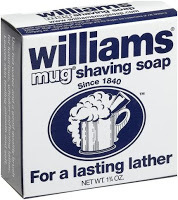 No business connection to G. Mennen Williams
No business connection to G. Mennen WilliamsThe bridge's highest profile supporter was G. Mennen Williams--Michigan's Democrat governor. Williams' mother was the daughter of Gerhard Heinrich Mennen--founder of the Mennen brand of men's personal care products. Williams' Mug Shaving Soap--no relation--was a well-known men's product. Some political wag conflated the two and dubbed Governor Williams "Soapy." The Mackinaw Bridge project soon became known among Michigan Republicans as "Soapy's Folly." Rather than chaff at the nickname, Williams embraced it and used it in his campaign literature. Governor Williams believed the bridge would open up a new trade route and provide opportunities to bolster Michigan's financially distressed Upper Peninsula.
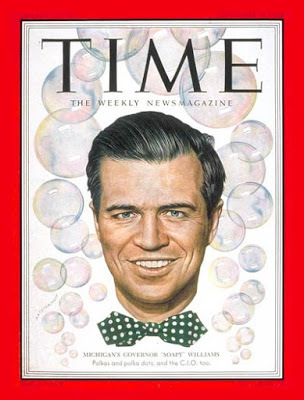 Michigan Governor G. Mennen Williams in his signature green bow tie.
Michigan Governor G. Mennen Williams in his signature green bow tie.By 1953, costs rose from the original $75,000,000 estimate to a proposed $90,000,000. The chairman of the Mackinac Bridge Authority reported that New York City investment firm B.J. Ingen, would sell bonds to finance construction. The financing would be handled entirely with private capital, without state funds involved with the project.
But bonds would only be issued on one condition. The Michigan legislature needed to approve $400,000 anually in highway funds for maintainance of the bridge. The revenue measure was a deal breaker until supporters pointed out that Michigan subsidized the straits ferry fleet to the tune of $650,000 annually. $400,000 for bridge maintainance was a bargain by comparison and the measure passed overwhelmingly.
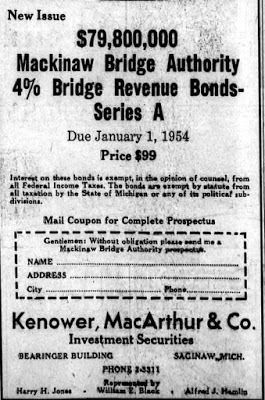
Because of a soft bond market, sales of bridge bonds were postponed for two months. Mackinac Bridge Authority Chairman Prentiss M. Brown told the press "we regret this decision because we lose the entire construction season." The completion date was postponed one year to November 1, 1957, at which time existing ferry service would be retired.
Once all the contracts were signed, the ground-breaking ceremonies were scheduled for May 7, 1954 in Mackinaw City and repeated on May 8th in St. Ignace. The Mackinaw City celebration began with a fly-over by six F-86 jet fighters. A three-mile long gala parade lead by the American Legion Drum and Bugle Corps of Detroit was followed by 75 floats and 40 marching bands and drill teams. They converged at Michilimackinac Park for speeches by bridge authorities and state politicians. During the ground breaking ceremony, the Bresser Chorus of Alpena sang the Star Spangled Banner. Later that evening, a fireworks display lit up the sky.
Construction began on May 7, 1954. The Merritt-Chapman and Scott Corporation was awarded the contract to build the substructure of the bridge, while the American Bridge Division of United States Steel Corporation was contracted to build the bridge's superstructure. U.S. Steel produced and fabricated all the steel used in the bridge's construction which took four years to complete.
On June 6, 1956, the Consumer Power Company began laying four underwater electrical lines across the straits to provide the first electrical power linking the lower and upper peninsulas. A tug-powered barge carrying four reels of cable began work on a clear, calm day and laid the cables beside Michigan Bell and Western Union telephone lines already in place.
The day before the inaugural opening on November 1, 1957, the Traverse City Record-Eagle ran an editorial lauding the new bridge: "Tomorrow will mark the beginning of a new era for Michigan history.... This bridge will make the Upper Peninsula an actual part of Michigan instead of a poor relation. The Mackinac Bridge will be a firm tie between the two peninsulas where only a loose connection existed previously. The opening of this bridge will be one of the most important days in Michigan history."
The original toll was a flat rate of $3.25 per car; the current toll is $2.00 per axle or $4.00 per car. Motor Homes and commercial vehicles are charged $5.00 per axle. The last of the Mackinac Bridge bonds was retired July 1, 1986, and the current fare revenues are used to operate and maintain the bridge.
The tradition of the Mackinac Bridge Walk on Labor Day began in 1958 with Governor Williams and state dignitaries leading the pack, but pedestrian traffic is only allowed on that day. Bicycles are not allowed on the bridge either. For a $5.00 fee, someone from the Bridge Authority will take cyclists and their bikes across the bridge.
 Some people have a fear of crossing bridges (gephyrophobia). The Authority has a Driver's Assistance Program that can be scheduled in advance or arranged at the toll booth. More than a thousand people a year would rather have someone drive them and their vehicle across the Straits.
Some people have a fear of crossing bridges (gephyrophobia). The Authority has a Driver's Assistance Program that can be scheduled in advance or arranged at the toll booth. More than a thousand people a year would rather have someone drive them and their vehicle across the Straits.Despite the remoteness of the bridge, the traffic flow averages 4.5 million vehicle crossings per year or 12,000 per day. After sixty-three years of hard use and winter's abuse, the Mighty Mac remains Michigan's most valuable and photographed asset.
Detroit Salt Mine



